Designed for assemblies and finishes in carpentry, the router is one of the essential tools. Practical and versatile, this machine allows you to perform various woodworking tasks with precision and precision results. You are probably wondering how to find a router adapted to your needs. So to help you find the right one, follow this guide.
Here is our commitment, to make sure that we provide the best user experience and content quality:
You can support us by using our links to make your purchases (at no extra cost to you)! This sometimes earns us a commission which allows us to remain independent. More about us
Our selection
"The Dewalt DCW604NT router impresses with a speed of 16000 to 25500 rpm and a cutting depth of 55 mm. The machine is equipped with…"
"Despite its price, the Bosch POF 1200 AE is a good compromise because of its versatility. Equipped with a variable speed drive and speed preselection,…"
"The GOF 1600 CE is a powerful tool designed with a 1600 W motor coupled with a constant electronic control. For more precision in use,…"
"Despite its 710 watts of power, the Makita RT0700CX2J stands out for its versatility and solid design. This ripper delivers variable power from 10,000 to…"
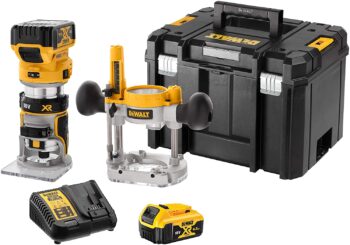
The Dewalt DCW604NT router impresses with a speed of 16000 to 25500 rpm and a cutting depth of 55 mm. The machine is equipped with a variable speed drive to adapt the optimal speed to the material.
277 £ on AmazonEquipped with a brushless motor without carbon, the Dewalt DCW604NT router is a high performance machine. It offers variable speeds from 16000 to 25500 rpm with a cutting depth up to 55 mm. To ensure high quality results, the router is equipped with an electronic speed control to adapt the best speed to the material being worked. It is also characterized by a 5-stage stop barrel for routing at different depths up to 36 mm and repetitive with a minimum of adjustment.
Practical and versatile, this Dewalt router has the eXtreme Runtime technology powered by an 18 V battery. Easy to use and robust, it integrates its motor in an aluminum housing that can be easily positioned in the routing unit. Compact and light, the device adopts a specific coating reducing vibrations and is equipped with 2 LED lights for more visibility at the level of the router. The router is even equipped with a spindle lock for quick accessory changes.
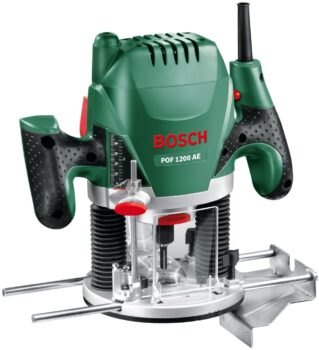
Despite its price, the Bosch POF 1200 AE is a good compromise because of its versatility. Equipped with a variable speed drive and speed preselection, it is designed for milling, grooving, chamfering, facing, shaping and profiling wood.
82,98 £ on AmazonPrecise, it offers functions for milling, grooving, beveling, facing, shaping and profiling all types of wood. Equipped with a 1200 watt motor, this model of router provides power from 11,000 to 28,000 rpm with an electronic speed controller and speed preselection. The machine features a 55 mm cradle stroke and adopts a parallel stop to ensure working accuracy.
The POF 1200 AE is also equipped with an integrated spindle locking system and has 3 collets of 6 mm to simplify the change of accessories. The POF 1200 AE is equipped with a protective cover to prevent wood chips from being thrown out and a dust extraction system with a vacuum connection to ensure clean work. The Bosch router is ergonomically designed with two solid and efficient softgrip handles, one of which holds the power cable.
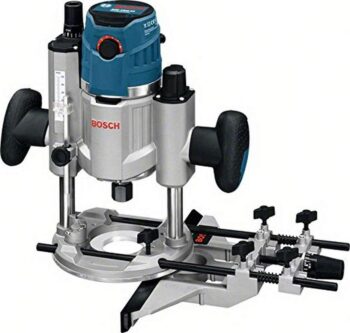
The GOF 1600 CE is a powerful tool designed with a 1600 W motor coupled with a constant electronic control. For more precision in use, it has a parallel stop with a micrometric adjustment.
431 £ on AmazonThe Bosch GOF 1600 CE is a powerful, ultra-precise router with a powerful 1600 watt motor. The device sets a constant electronic control with a smooth start for a work adapted to the material used. The router is equipped with LED lighting of the working area with a transparent base plate for even more precision. The main feature is the patented micrometric adjustment system for the adjustment of the milling depth in 1/10 mm steps.
The machine also has a reinforced column in the base with a fixed plunge function with a cradle stroke of 76 mm. Supplied with several accessories, the router includes a spindle lock with a flat hood cover for quick router changes and setup work. Versatile, stable and efficient, it has a power range of 10,000 to 25,000 rpm with minimal vibration emission.
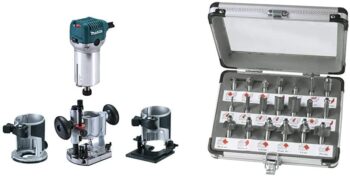
Despite its 710 watts of power, the Makita RT0700CX2J stands out for its versatility and solid design. This ripper delivers variable power from 10,000 to 30,000 rpm.
198 £ on AmazonAny specific needs?
Your guide :
Rate this buying guide :By rating this buying guide, you are helping us to reward our best writers. Thank you!
| TOP OF THE LINE | CHEAP | TOP OF THE LINE | ALTERNATIVE | |

In accordance with our commitment, this buying guide does not contain any sponsored products. |
 8/10 |
 8/10 |
 9/10 |
 8/10 |
| OUR SELECTION |
DEWALT - XR 18V - DCW604NT-XJ
|
Router Bosch - POF 1200 AE
|
Bosch Professional GOF 1600 CE
|
Défonceuse et Tronçonneuse - Makita RT0700CX2J
|
|
The Dewalt DCW604NT router impresses with a speed of 16000 to 25500 rpm and a cutting depth of 55 mm. The machine is equipped with a variable speed drive to adapt the optimal speed to the material.
|
Despite its price, the Bosch POF 1200 AE is a good compromise because of its versatility. Equipped with a variable speed drive and speed preselection, it is designed for milling, grooving, chamfering, facing, shaping and profiling wood.
|
The GOF 1600 CE is a powerful tool designed with a 1600 W motor coupled with a constant electronic control. For more precision in use, it has a parallel stop with a micrometric adjustment.
|
Despite its 710 watts of power, the Makita RT0700CX2J stands out for its versatility and solid design. This ripper delivers variable power from 10,000 to 30,000 rpm.
|
|
|
Power source
|
18V rechargeable battery
|
On electric outlet
|
On electric outlet
|
On electric outlet
|
|
Motor power
|
930 watts
|
1200 watts
|
1600 watts
|
710 watts
|
|
Motor speed
|
16,000 to 25,500 rpm
|
11,000 to 28,000 rpm
|
10,000 to 25,000 rpm
|
10,000 to 30,000 rpm
|
|
Depth of cut
|
55 mm
|
55 mm
|
76 mm
|
40 mm
|
|
Dimensions & weight
|
45 x 35, x 33.5 cm & 2.4 kg
|
29 x 29 x 16.2 cm & 3.4 kg
|
44 x 39 x 36 cm & 5.8 kg
|
9 x 9 x 20 cm & 2.7 kg
|
Help us improve this table:
Report an error, request the addition of a feature to the table, or suggest another product. Thank you for your kindness!
We spend thousands of hours each year studying the major specialized websites, analyzing products of hundreds of brands and reading user feedback to advise you on the best products.
We are a product review company with a single mission: to simplify your buying decisions. Our research and testing helps millions of people every year find the best products for their personal needs and budget.
To support us you can: use our links to make your purchases (which often earns us a small commission), share our articles on social networks, or recommend our site on your blog. Thanks in advance for your support!
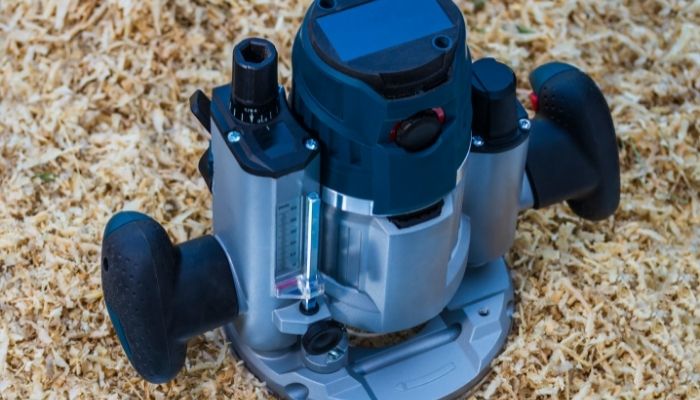
The power of the router is a decisive criterion of choice. Try to define your choice according to the work you want to do. This power will vary between 500 W and 2400 W.
Note that on the market, there is the corded model and the cordless model.
At this level, the router will be defined by the speed at which the cutter or the bit will turn. This performance will also be determined by the number of revolutions per minute of the router.
Most routers available offer speeds ranging from 8000 rpm to over 30,000 rpm. But your choice will also be oriented according to your use. You should know that if you want to make small size routers, the perfect speed should be higher or around 20000 rpm at least.
On the other hand, if you want to make large milling cutters, you will have to opt for rather low motor speeds of about 15000 rpm at the most.
When you buy a router, be sure to check the minimum and maximum speed values to ensure that the router will match the work you are planning.
First, your router will have a soft start to ensure good control of the tool. Then it will also be essential to have a variable speed drive to control and dose the rate depending on the desired work and the hardness of the wood or similar material.
Some routers on the market do not have speed options, while others with versatile functions will be equipped with variable speed motors with multiple speeds.
So if you want to work on different aspects of woodworking or similar materials, this criterion will be very important. Only because some applications will require slow speed, while others will require more power.
This criterion will be essential to be able to set the results according to your machining expectations. This data will also be available on the product data sheet to better direct you in your needs.
Know that with some router models, you will have the availability of a precision depth of cut setting according to the expected wood machining. This is also the maximum depth for milling or cutting wood or similar materials.
The base sole is the part in direct contact with the material to be worked. At this level, we distinguish between a fixed base and a plunging base.
The first is limited to work that can be considered for edge cutting, while the second will be more versatile. The sole of the router can also take a round or semi-round aspect.
The round sole allows for better guidance of the tool on the wood and the half-round is considered the least cumbersome. It is best to opt for interchangeable bases to adapt your tool according to your needs and preferences.
Other than the other criteria, it is also necessary to question the different accessories that come with the router. The availability of these accessories will guarantee the versatility, reliability as well as the practicality of your router.
You should know that the accessories needed for a router will be at least a router, a depth compensator, a centering spindle, a copying ring and collets.
But some routers come with a range of additional accessories, such as a stationary stand, a parallel stop, a chip extractor, a chip deflector or an integrated work light and a carrying case.
It is important to respect the direction of routing when using your router. It is a factor to take into account in order not to damage your piece of wood and not to be carried away by the tool. It will mostly be a matter of the orientation of your workpiece in relation to the direction of rotation of the router. Working in the wrong direction of the milling cutter or in opposition, you will risk damaging the wood or breaking the cutter.
As an example:
But be aware that there are a few exceptions if you want to trim fine wood veneer.
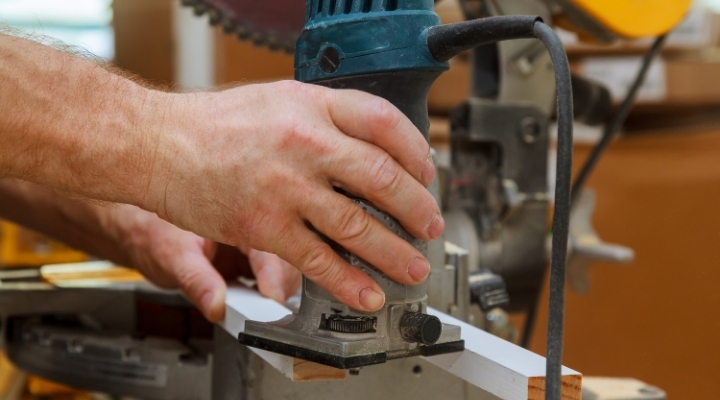
The flush router is the most compact and has a cutter suitable for all types of wood. It is a tool for making a straight cut from the embellishment details to its ends.
This type of router is also used to provide a uniform look to a material. In addition, it can be used to work with wood for decorative inlays, window cutouts, hinge mortising, edge forming, slot cutting and small scale dovetailing, etc.
Although it is very convenient and handy, the flush router limits its cuts to a maximum size of 6 mm drill bit or router. To this end, this equipment will be quite limited for intense and important work.
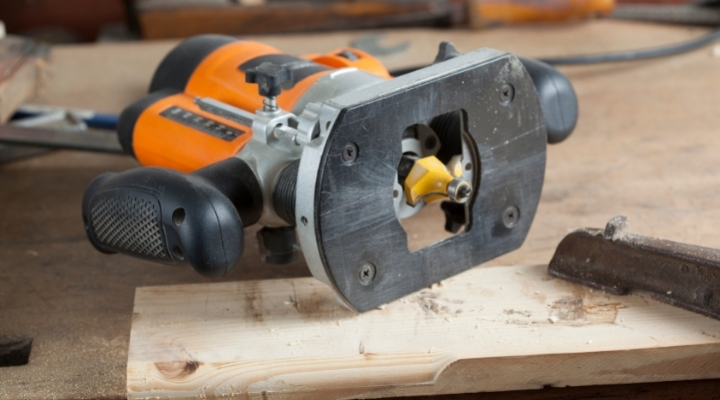
The copy router is mainly a work tool designed to reproduce any type of shape with a cutter with ball bearings at its tail. This bearing may have a different diameter than the cutter.
This last one is in most cases used with a template that is fixed on the piece to be machined. And in order to reproduce a perfect contour, the bearing of the milling cutter will be used as a support on the edge of this template.
The copy router, as its name indicates, will be limited to a shape reproduction design. It will be mostly restricted both in cutting diameter and depth.
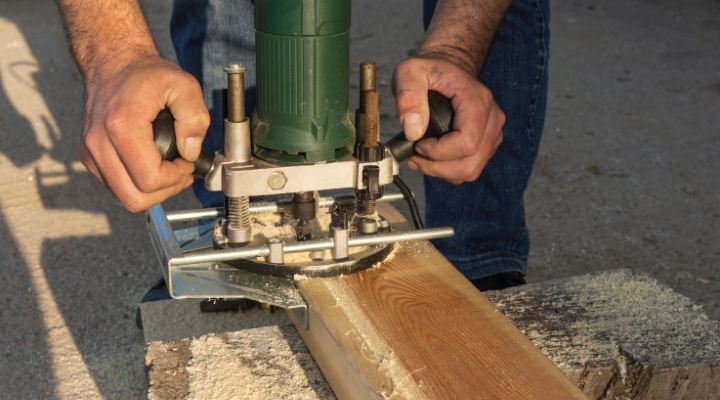
The grooving router is the most versatile and powerful model on the market by its ability to make more stylish cuts, and even the most complex ones with more precision. It is mostly used by professionals and often adopted in large-scale works.
This type of router can work with all types of wood and similar materials, even the most robust. This router can also be used to make large-scale panel cuts or dovetail cuts and will be less limited in the diameter of the cutters.
In this regard, there are two types of grooving cutters, one with two teeth, intended for circular and straight grooves. The second type of slot is the T-shaped slot cutter, designed for milling two recessed parts.
A router is an electrically powered tool designed to work on wood pieces in carpentry and cabinet making. It is a versatile machine that can be used to make engravings, dovetails or grooves.
It is mainly used for finishing and assembly work. Equipped with an electric motor, its cuts result from the rotation of a bit called a milling cutter. Like all electric equipment, the router exists in portable and stationary models.
The router offers skills ranging from cutting to profiling with great precision. It allows straight or circular cuts, reproduction of shapes with a template or a copy ring and many other functions. However, the machine is limited to a certain cutting depth.
A jigsaw is a cutting device with a toothed blade for cutting panels, plastic and aluminium.
Unlike the router, the jigsaw adopts a fairly thin, narrow blade that moves back and forth rapidly to perform its cutting functions. The small size of its cutting device allows it to be very handy in reproducing straight or rounded shapes according to a chosen layout. Its cutting depth can reach up to 9 cm in thickness.
The advantage of the jigsaw is that it can be used to cut thin metal sheets and profiles with suitable blades. However, the machine is limited to cutting without the finishing function.
Both types of equipment have their own advantages and limitations in terms of their functions, but they also share common features when it comes to woodworking. For simple cutting, the jigsaw will be the ideal option but will remain restricted to finishing and profiling.
While the router will be very versatile for woodworking but will still be limited on cutting depths. Your choice will thus depend on your objectives and your use. But if budget is not an issue for you, you can also opt for both tools to enjoy a complete result.

Versatility
The main advantage of the router is its versatility to perform several tasks related to woodworking and cabinetmaking. It is also ideal for assemblies and finishes as well as various jobs such as grooves, dovetails, edge-molded profiles or mortises. Some multi-functional routers even allow not only the trimming and profiling of wood, but also of plastic and other similar materials.
Precision
Apart from its versatility, the router is an easy-to-use tool for various precision work in carpentry and cabinet making. This precision is guaranteed by a parallel guide that provides great stability and horizontality in use. Moreover, its characteristics allow it to be precise and easy to handle.
For example, the availability of ergonomic handles for a firm and comfortable guidance or the support of copying ring designed to reproduce different shapes to perfection etc.
The performance
As a tool, the router is intended to facilitate the task of woodworking. Powered by an electric motor, the router is equipped with a rotary shaft motor that causes the electroportative reaction of the device by offering the necessary performance.
However, its performance will vary depending on the motor of each unit to provide a suitable speed. On average, this power ranges from 600 to 2000 W providing a capacity ranging from 8000 to 30000 rpm, depending on the machining and the hardness of the wood.
Practicality
The router is designed to meet a wide range of routing applications. It has a built-in electronic variable speed control to ensure a constant speed under load. This type of tool is used to cut a specific area on hard materials such as wood and plastic.
The unit has built-in features for accuracy and also allows for a cutting attachment in a hand-held planer table. Its technology supports the trimming of laminates or with the appropriate jig, it can be used to recess door hinges and lock faces.
Ergonomics and ease of use
In this regard, it will be mainly the ergonomics of the handles and the weight of the machine to ensure a perfect grip. In general, the weight of a router is between 3.5 and 6.5 kilograms. The higher this value is, the lighter the machine should be to ensure a more comfortable use.
The handles are ergonomically designed, which makes it even more convenient to hold. All of this allows the router to be handled with precision and to be more efficient.
In our opinion, the best brands of rippers in 2022 are :
Founded in Germany in 1886, the Bosch brand is well known in the field of electric tools. Its range of routers seduces above all by its quality-price ratio and its practicality. Its products are aimed at both professionals and amateurs. The Bosch brand offers two ranges for DIY: the professional range in blue and the general public range in green.
Subsidiary of the Black & Decker brand, the Dewalt brand stands out for its quality hand and power tools. Supplying robust, powerful and durable DIY equipment, it is one of the references in the field of construction and industry. Dewalt routers focus on performance for perfect woodworking finishes.
Of Japanese origin, the Makita brand is established in over 150 countries. It mainly offers professional quality electroportable do-it-yourself equipment reserved for an initiated public and for a sustained use. Makita never stops innovating and offers a variety of range of ripper with cordless models, ultra-light, fast as well as precise to satisfy the users.
Einhell is a German brand founded in 1964 and present in the UK since 2008. The brand is focused on the manufacture and sale of DIY and gardening tools for professionals and individuals. Einhell is best known for the quality, durability, reliability and performance of its tools. It adopts a strategy of continuous innovation in order to offer products at the cutting edge of technology with excellent value for money.
Founded in 1943, Ryobi is one of the most dynamic and innovative Japanese manufacturers of power tools, stationary and gardening tools. Its products are both beginner and advanced oriented with a wide range of DIY equipment. The brand strives to offer models with the best quality-price ratio in order to satisfy and meet the needs and requirements of all.
The diagram below will help you to get an idea of the typical prices for each price range (entry-level, mid-range and high-end).
However, more expensive does not necessarily mean better.
We therefore advise you to always consult our ranking before deciding, rather than blindly relying on price ranges.
Clean your router
Your router accumulates dust and other debris over time. To effectively get rid of these accumulations, there is nothing better than to use products designed for this purpose. Available in specialized stores, you can also make your own by diluting baking soda in water.
Then apply your preparation on the accessories and let it act for a few minutes. Then rinse them under water while scrubbing them with a brush before drying them. In order to protect the different elements, it is recommended to store them separately in a compartmentalized box away from humidity. Be aware that regular cleaning is an important part of maintenance after each use.
Maintain your router to maintain its performance and longevity
Although a sturdy tool, a router requires some maintenance to keep and maintain its performance and durability. It should be noted that metal components are not immune to rust impacting the performance of your tool.
In fact, besides cleaning, maintenance is a very important point to consider. Thus, it is suggested to apply anti-rust products on the metal parts to protect them. Also think about polishing and lubricating the bearing of the machine by putting a drop of specific oil spray on it.
Sharpen the cutting edges of the routers
In order to keep and preserve the cutting performance of the router, try to maintain the cutting edges of the cutters by refreshing them on ordinary stones with water or oil. On the other hand, to get a real sharpening, it is much more advisable to entrust your router bits to a professional.
How to guide your router during machining
To guarantee cutting accuracy to the router, it is essential to have a guide rail, especially for grooves. But in the absence of the guide rail, there are many alternatives to solve this problem.
The first solution is to adopt a cleat or a mason's rule to guide the router. To do this, make sure to place the cleat according to the direction of rotation. It will serve as a blocking device by keeping a good distance. For a greater depth of groove, it is recommended to make several passes at progressive depths.
The second alternative is to use a parallel guide. The fence, again, should be placed opposite the direction of rotation to counteract the effect of the router moving to one side depending on its direction of rotation.
Safety rules when using your router
Despite the proliferation of safety devices, there are precautions to be taken when using a router. First, it is important to wear a mask, gloves, goggles and ear protection if needed. Secondly, it is imperative to ensure that the workpiece is securely clamped with a clamp or vise.
Then, before starting your router, make sure that all its parts are properly installed. In this regard, it will be especially important to make sure that the router is properly installed and secured according to the standards. And finally, to avoid damaging your tool, try to unplug it only when the router is completely stopped.
The variable speed drive is mainly intended to adapt the speed or the number of revolutions per minute of the cutters to your woodworking or cabinetmaking work. It is also important to consider the relationship between the size of the cutter and the motor speed on all your work, otherwise the wood being worked may be damaged or splintered.
In general, the chuck of a router is designed to hold a specific shank diameter router bit. Sometimes to change the diameter, you have to change the internal part of the chuck which is the collet. Most routers come with at least 2 collets of different diameters ranging from 6 to 8 mm and 8 to 12 mm. The collets should also be replaced if they are damaged, as they can damage the cutter shanks and affect the whole system.
The soft start will allow for a smooth start up for handling and control of the tool up to its preset speed. This feature is one of the most important criteria when handling a router with a large cutting size and to accommodate the heaviest of jobs. Without a soft start, the machine will run at full speed when started.
As mentioned before, a router can be used to work on all types of wood and wood-like materials such as plastic, aluminium, brass and steel. It will mainly be solid and soft materials. But the quality and type of cutters to be used on the router will depend on the hardness of the wood or material to be processed.
Every month we help more than 1 000 000 people buy better and smarter.
Copyright © 2022 - Made with ♥ by buyingbetter.co.uk
Your reviews and buying guides 0% advertising, 100% independent!